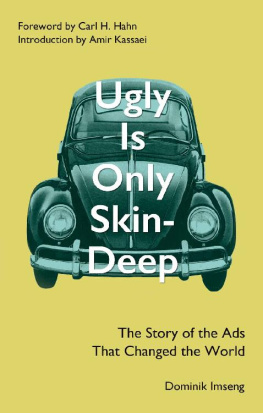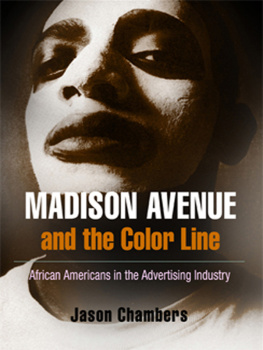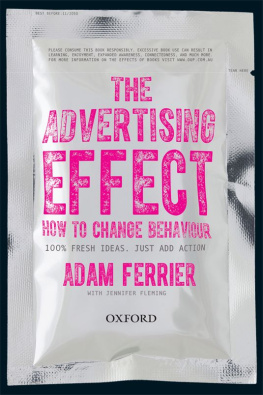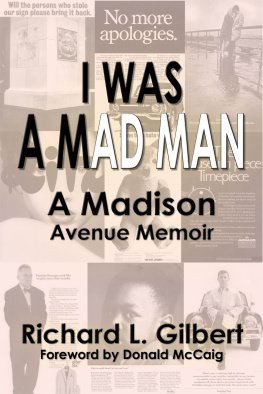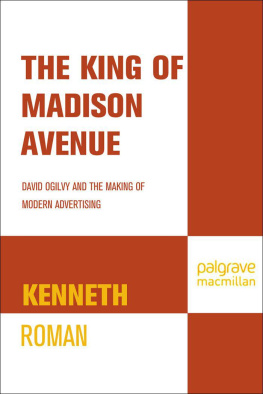THE REAL
MAD MEN
Copyright 2011, Elwin Street Productions
Conceived and produced by
Elwin Street Productions
144 Liverpool Road
London N1 1LA
www.elwinstreet.com
First published in the United States in 2011 by Running Press Book Publishers, A Member of the Perseus Books Group.
All rights reserved under the Pan-American and International Copyright Conventions.
This book may not be reproduced in whole or in part, in any form or by any means, electronic or mechanical, including photocopying, recording, or by any information storage and retrieval system now known or hereafter invented, without written permission from the publisher.
Books published by Running Press are available at special discounts for bulk purchases in the United States by corporations, institutions, and other organizations. For more information, please contact the Special Markets Department at the Perseus Books Group, 2300 Chestnut Street, Suite 200, Philadelphia, PA 19103, or call (800) 810-4145, ext. 5000, or e-mail .
ISBN 978-0-7624-4243-0
Library of Congress Control Number: 2011926064
9 8 7 6 5 4 3 2 1
Digit on the right indicates the number of this printing
Running Press Book Publishers
2300 Chestnut Street
Philadelphia, PA 19103-4371
Visit us on the web!
www.runningpress.com
PICTURE CREDITS
Reproduction of images authorized by:
Advertising Archives: (bottom)
Alamy: front flap,
Amil Gargano:
Avis Rent-a-car:
Bayer HealthCare LLC:
Bimbo Bakeries USA, Inc:
Chivas Brothers:
Corbis Images:
Coyne & Blanchard, Inc., DBA Communication Arts:
DDB Worldwide Communication Group Inc.:
Duke University, North Carolina:
El Al Israel Airlines:
George Lois:
Getty Images:
iStockphoto:
Jon Williamson:
Judith Wald:
Kathryn Krone:
Lyndon Baines Johnson Library, Texas:
McCann Erickson:
McDermott Library, The University of Texas:
Ogilvy & Mather:
PLR IP Holdings, LLC:
Talon International:
The Hertz Corporation:
The Procter & Gamble Company:
Viyella: (top left)
Volkswagen Zubehr: (top)
Volvo Car Corporation: .
Wisconsin Historical Society: (right)
Young & Rubicam:
Figures featured on the endpapers include: FrontBill Bernbach, Gene Case, DDB, Amil Gargano, Helmut Krone, Jeff Metzner, PKL, Jack Tinker, Judith Wald, Bob Wilvers, Young & Rubicam, and Bernie Zlotnick. Back21 Club, Carl Ally, Jerry Della Femina, Carl Fischer, Gilbert Advertising, George Lois Ron Rosenfeld, and Young & Rubicam.
With thanks to the following for supplying endpaper images: Carl Fischer, Amil Gargano, Kathryn Krone, Bob Kuperman, George Lois, McCann Erickson, Judith Wald, and Bernie Zlotnick, 21 Club, DDB Worldwide Communication Group Inc., El Al Israel Airlines, Carl Fischer, Richard Gilbert, George Lois, Judith Wald, Bernie Zlotnick.
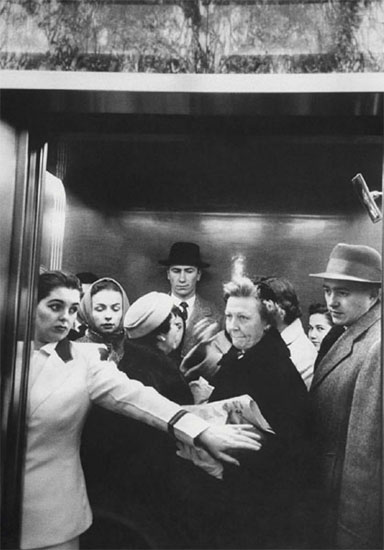
Contents
DEDICATION
To the gentle Dan Levin, my group head at CDP, because he gave me my first break, taught me with immense skill and patience, and set me on the road; because he introduced me to the US advertising of this era and explained its importance; and a little because in 1967 he had an E Type Jaguar and that was all the incentive I needed. Sadly he died in October 2010.
AUTHORS NOTE
In his 1964 novel The Advertising Man, Jack Dillon makes one passing reference to those then employed in advertising on New Yorks Madison Avenue as Mad Men. Apart from that, I found no evidence that the expression was in any sort of use until the AMC series of that name. For that reason, and to avoid confusion, throughout this book the phrase will refer only to people, events, attitudes, and images in the TV drama and not the world of 1960s New York advertising.
All quoted material is either referenced directly in the text, or can be found in the sources provided at the back of the book.
A dvertising is a wonderful business in that it recognizes talent very quickly. It applauds it, rewards it, and promotes it. The only problem is, it also forgets it very quickly.
The word history in our industry is almost a dirty word. Were obsessed with tomorrow and the next big thing. In many ways thats what makes it so exciting. Constant invention is at its core. Creativity is, after all, about breaking something down and putting something new in its place.
But sometimes this can work against it. I was lucky enough to be taught history by an inspirational teacher whos mantra was history isnt about the past, its about the future. Understanding where we came from, why we did what we did, and how it could influence tomorrow was at the heart of his teaching.
It is this that makes this book so special.
Yes, it is about the past. Its about a moment in time when everything changed and modern advertising was born. It will make you laugh and wonder at the characters that inhabit these pages, and teach you how to recognize true creativity as opposed to the illusion of it.
It will also give you an insight in how to run a creative company, and make sure it continues to be successfulBernbachs brilliantly insightful letter to his staff about the dangers of bigness and conformity should be plastered across the walls of any creative organization. Not that this is a how to book. Far from it. But like any great story it carries within it lessons that go beyond the intended narrative.
Andrew Cracknells writing captures the passion, madness, and mayhem that is all part of a creative revolution; the courage and determination it takes to succeed and, most of all, how to conjure magic out of nothing.
Y ou dont have to be an adman to love the Creative Revolution. All thats required is an appreciation of how Madison Avenues ad agencies veered from hard sell advertising in the 1960s, abandoning brain-jarring repetition and hyperbole, creating instead a softer, more colloquial selling premise. Radiating good taste, humor, real-looking people, and down-to-earth copy, their amiable messages began relating more directly to real everyday life in America.
Cut to July 2007, and the debut of the AMC cable networks Mad Men series, billed as a serious recreation of Madison Avenue in the sixties, when the Creative Revolution was reenergizing ad agencies. Most admen who survived that decade and tuned in to Mad Men were hoping it would reflect the energy that was coursing through the business during that decade. But the TV version instead focuses on a fictitious new agency, Sterling Cooper Draper Pryce, that is curiously immune to the energizing creative work going on all around it at smaller, less stuffy start-ups.
Mad Men did succeed, however, in opening memory floodgates; veteran Creative Revolution pioneers were asked to reminisce, and now, in these pages, Andrew Cracknell brings them together to provide the real-life details and contrasts to the Mad Men storyline. With the back stories of landmark ad campaigns here, we witness a shift from musty old agency dos and donts (i.e., leave room in the ad for the logo) to the challenging fresh ideas only approach. Agency writers and artists, no longer confined to separate cubicles, would henceforth work together as teams, in one office.
As the new ads won acclaimand increased salesyoung men and women started to take notice. And when they began setting off in pursuit of real world careers, many were drawn to the agency business.
How to break in? What about the social barriers? This Revolution was breaking down those barriers. Andrew Cracknell describes the paths many future advertising legends had to follow to get their first jobs, and how they would later open doors for others. Many of them bore vowel-rich ethnic names that were notably missing from agency office nameplates. Their stories are universally applicable; learn from them.




